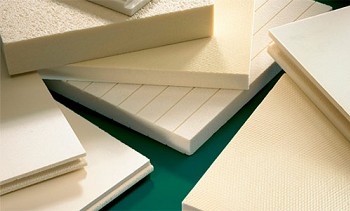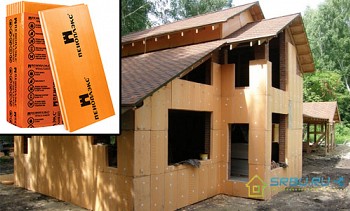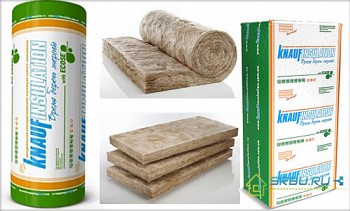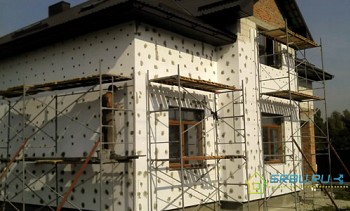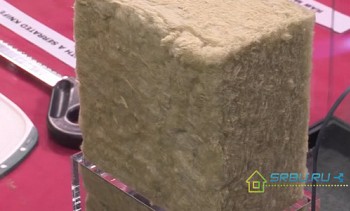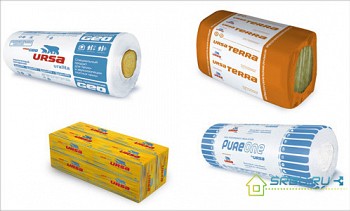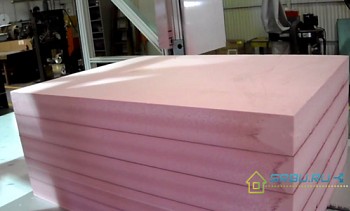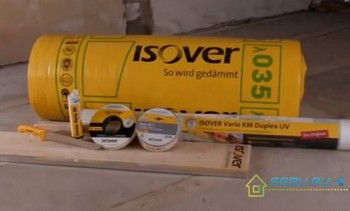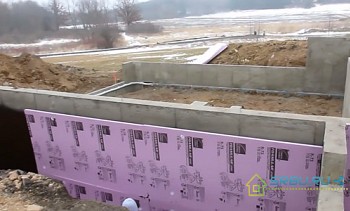Developers often argue about how to insulate walls, which is better than mineral wool, or polystyrene? It seems to some that EPPS (extruded polystyrene foam) would be the best option for thermal insulation at home, but not to others. In principle, the thermal conductivity coefficients for each of these heat insulators are very close. But the rest of their parameters are too different, so we will deal with everything in order.
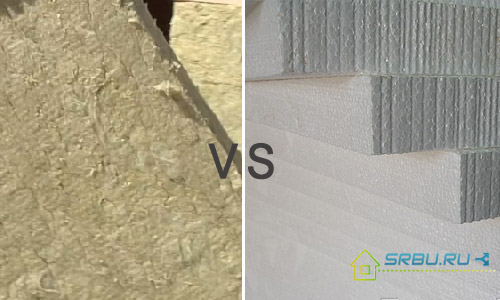
What is the difference between mineral wool and polystyrene?
Attention! Under the concept of mineral wool, several types of insulation are meant, for more details see the material: Technical characteristics of mineral wool, its brands and selection criteria. This article will focus on mineral basalt wool, because as soon as its properties can be compared with polystyrene and make a choice. All other types of mineral wool will lose both basalt wool and expanded polystyrene.
The ability to pass steam
The vapor permeability coefficient of both conventional and extruded polystyrene foam is 0.03 mg / (m · h · Pa). In mineral wool, this figure is 10 times greater. This means that her ability to pass evaporated water is better. Although in practice the thermal insulation of the walls consists of several layers with different vapor permeability. The resulting vapor permeability will correspond to the characteristics of the material for which it is minimal. Therefore, different types of insulation close to each other.
If the insulation system has a polymer structure, then mineral wool should not be used. The fact is that both the base of the system and the outer layer made of polymer pass moisture poorly. If the condensate gets inside by soaking in a layer of mineral wool, then the water will not be able to evaporate, and the insulation will lose its thermal insulation properties. After all, if the cotton wool is not even wet very strongly, then it will become bad to keep heat. Therefore, when warming a house, you need to be guided by the rule: a good vapor barrier should be made from the side of the house, and material with a higher vapor barrier should be laid closer to the outer walls. So excess moisture will go outside.
Polyfoam does not pass steam, but also does not accumulate. Steam penetrating from the side of the room is usually diverted through the joints and irregularities of the insulation.
This property can be either a plus or a minus, therefore, as they say, a draw.
Ability to resist fire
Here, mineral wool has a clear advantage - after all, this material does not burn at all. Note that some types of basalt fiber wool can withstand ambient temperatures up to 1000 degrees. Celsius. Expanded polystyrene is not only easy to melt, but also able to burn on its own. Some may argue that flame retardants are added to the polystyrene foam that interfere with the maintenance of combustion. Yes, they are quite rightly added, but only their action eventually disappears and the polystyrene begins to maintain combustion. And here’s the video that demonstrates what happens when the extruded polystyrene foam, basalt wool, polystyrene foam, polyurethane foam and ecowool are burned.
Video: How heaters burn
Minvata + |Styrofoam -
Price issue
According to this parameter, both heaters are approximately equal. The cost of mineral wool from basalt rocks and polystyrene varies depending on their density. Affects this indicator and brand.
What is more convenient to mount
Expanded polystyrene (both conventional and extruded) is more durable and elastic than mineral wool. It is easy to cut and grind.However, it is rather problematic to glue this insulation so that at the joints of individual elements to avoid the appearance of cold bridges. This problem is solved by the use of foam sheets with a L-shaped edge. Mineral wool can be dense and elastic only in mats laid in the frame and on the facade. But the joints of its sheets are so small that there can be no talk of cold bridges.
Minvata + - |Styrofoam +
Ability to resist heat loss
As already mentioned, manufacturers indicate almost the same values of the thermal conductivity of mineral wool and polystyrene. It was experimentally possible to find out that polystyrene foam with insulation still gives better results. The fact is that only very dense basalt wool, produced in the form of plates, has the same thermal conductivity. But the rolled material, which after rolling becomes looser, is inferior to expanded polystyrene in thermal insulation properties.

After all, the faculty inside is a lot of closed cells with air. This structure allows the material to retain heat very well.
But mineral wool releases warm air outside - after all, it does not have isolated cells. Layers of air as a result of convection move from the warm side of the insulator to the cold (outer) side. And the room insulated with mineral wool, as a result, cools faster than the one that is insulated with polystyrene foam.
Any polystyrene, even the most inexpensive, as a heat insulator works better than mineral wool. After all, all manufacturers of refrigeration equipment and water heaters choose it for insulation. If these heaters are used together (in multilayer thermal insulation), then polystyrene foam should not be outside. And then the requirement to increase the vapor permeability from the inside of the walls to the outside will not be fulfilled. To comply with this condition, mineral wool should be used as the outer layer. It seems that now the answer to the question is clear: what is warmer - polystyrene foam or mineral wool.
Minvata - | Styrofoam +
On the issue of environmental friendliness
Previously, styrofoam was made from styrene, and freon was used in the manufacturing process. Such material was not suitable for use inside homes, as it emitted harmful gases. But now more stringent requirements are placed on the environmental friendliness of materials. Both European and Russian manufacturers stopped using freon for the manufacture of foam. Therefore, for outdoor work, it is absolutely safe, in any quantities, but indoors it should be used carefully - not very carried away by the quantity.
Minvata + | Styrofoam -
On the service life of expanded polystyrene and mineral wool
Often you can hear or read that after 8 or 10 years, the foam begins to collapse. But this only happens if the material has no protective coating. And then rain, snow and the rays of the sun (in particular) are really capable of damaging the foam. But in heat-insulating systems, PPS usually has a decorative coating on top. And the moisture formed as a result of the condensation settles out of it through moisture transfer. In old refrigerators, foam did not do anything in 30 years. And German houses, insulated by them, stand for 35 years (Polish - 20 years, Baltic - 15 years). We will keep this in mind when deciding what to choose - expanded polystyrene or mineral wool.
As for basalt wool, its fibers are made of volcanic rocks, so they are not afraid of various aggressive environments, this naturally affects the great durability of this material.
Minvata+ | Styrofoam-
In addition to conventional polystyrene, there is also extruded polystyrene foam, which surpasses the characteristics of both simple polystyrene and mineral wool. EPSP inside has cells of the same, evenly spaced. It can be used not only for insulation of floors, walls and roofs, but also for the construction of various buildings and structures, as well as roads.Extruded polystyrene foam is used not only in the construction of private houses, but also on an industrial scale.
What is better to insulate with foam
This material proved to be very good in those places where the air humidity is high enough but insulation is required.
- Polyfoam will not do anything when in contact with wet ground, so they can perfectly insulate foundations, as well as various engineering structures located underground. Dozens of years will pass, and the insulation will remain the same as at the very beginning. It is often used in the construction of multilayer foundations as a middle layer. It turns out a very reliable and high-quality foundation.
- In the construction of houses, without basements, on a monolithic foundation, it is also convenient to use expanded polystyrene. Plates of this material are laid on a flattened platform, and then a layer of concrete is poured on top of them. The plates themselves can be either one row or several. After the concrete has hardened, the walls of the house begin to be erected.
- So that the foundation of the house does not freeze, it is very effective to insulate with foam plastic not only the vertical, but also its horizontal part. Polystyrene boards are laid along the foundation. Then they fall asleep, if necessary, additionally laying a waterproofing layer. This method of warming reliably protects the foundation from frost.
- The walls of houses (both inside and outside) can also be effectively insulated with polystyrene foam. It is best if these walls are block or brick. A high heat-insulating effect is achieved when polystyrene foam is used for insulation of indoor premises, while the formation of a dew point is not observed.
- For non-ventilated type roofs (warm, flat roofs), the PSBS polystyrene foam brand is used. A waterproofing layer is required to be placed on top. For cold roofs that are ventilated, thermal insulation is carried out differently. Polyfoam isolate the inside of the roof, certainly leaving room for ventilation. This prevents water vapor from condensing.
- Floors and floors between floors are also well insulated with foam slabs. A layer of insulating material is placed under them, and on top they are poured with concrete.
- A variety of packaging is also made from polystyrene foam, and it is also used for the thermal insulation of refrigerators, freezers and special isothermal vans.
What is better to insulate with mineral wool
- For wooden houses, you do not have to choose which is better - expanded polystyrene or mineral wool. “Breathing” walls made of wood cannot be insulated with polystyrene foam - this will negate their useful properties. Therefore, they are insulated with mineral wool. And in buildings built from other materials, mineral wool sheathed partitions, floors, ceilings, ceilings. If the external walls are insulated, then a ventilated facade of a suspended type is made. Vapor barrier membranes are an integral part of this design.
- Mineral wool is isolated by attics, attic rooms and floors of houses, pitched roofs. At the same time, they leave room for ventilation.
- Brick houses with a small number of floors, in which mineral wool is the middle heat-insulating layer. It is also used for three-layer panels of concrete, reinforced concrete, as well as a sandwich of panels in a metal shell.
- They are used in those places where it is necessary to provide good protection against very hot objects, because basalt wool can withstand temperatures up to 1000 0C.
- Frame structures of any type, it is better to insulate with mineral wool. In addition, it is used for soundproofing. Moreover, this material is well suited for horizontal, and for vertical, and for curved surfaces.
- Mineral fiber wool, released in the form of soft plates, can wrap pipes of heat, water, gas pipelines. It also isolates industrial equipment in enterprises.

